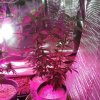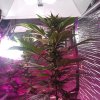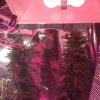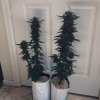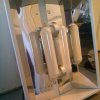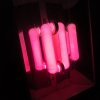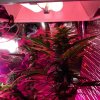NeWcS
Well-Known Member
So, I have been wanting to get some new lights as I am still using older LED lights.(ufo’s,blackstar panel, etc.). While the LED’s have provided me with lots of weeds over the past few years I think it’s time to step up my game some. Have been looking mostly at COB style led panels. However, for the past couple years I have also been looking into induction lighting as well. I remember seeing a sample unit in a local grow shop as well as at a garden expo. Induction lights are well priced and within my budget. As long as they come directly from the manufacture. Retail on them is waaaaaaay too high at this point. So I contacted a manufacture directly and did some back-and-forth emailing with a sales rep and was able to get a sample unit to try. (Now, before the haters start to hate let me explain why I don’t run HID’s. I grow under my home in a crawl space, with very little height. The ceiling in my flower area is about 4ft tall. So I need to be able to grow my plants fairly short and as close to the lights as I can. I am sure I could pull off a cool tube or a sealed vented hood but that would mean having to deal with heat and ventilation. Which I would like to avoid.)
So they sent me a 100w induction light in a fixture with a ballast and mounting chains and hangers. All I had to do was wire a plug to the ballast and plug it in. As you can see from the pictures it emits a predominately red color. This is the ‘flowering’ model with their ‘custom spectrum’. So unlike some of the other lights I have seen in person which seem to use cool white 5000k~ or warm white 2700k~, these are designed with flowering in mind. I guess. Looks like the inside of the bulb was colored before the bulb was sealed and assembled. Before I go any further; If you need to learn more about induction lighting and the technology behind it I would suggest doing some research, I am not the person to ask. I just know how to grow plants and hang the light. J
First thing I thought when the light showed up was “damn, That’s a big ass box for a 100w light”. And rightfully so. The hood is a beast. Turns out the same hood they use for this 100w is also used for their 200w. The hood is very well made and strong. It was damaged in shipping but considering the way it was packed, it could have been a hell of a lot worse. The inside of the hood is lined with some very reflective material which seems to do a good job of reflecting the light out of the hood. The ballast is mounted on the top of the hood. The ballast creates NO heat. None! Its actually cold to the touch., The heat from the bulb is almost zero as well. As long as the plant isn’t touching the bulb its fine. When touching the bulb I am only able to do so for a couple seconds. It’s pretty hot, but none of that heat is transferred away from the bulb. Again, unless you or the plants are touching the bulb you’ll feel nothing. From the pictures you can see I ran the plants right up into the hood and right next to the lamp. No sign of burn.
I ran 2 Sour Blueberry plants under the light. Each were in a 1gal grow bag with 100% perlite. They were under the light for probably 95% of their life in flower. There were a couple days were I may have not put them back while moving plants around. But whatever. I normally train all my plants but these two I didn’t. I wanted to run the plants naturally to take the human equation out of the test as much as possible. I feel this gives me a better idea of light penetration when testing.
When I first got the light and plugged it in I was stoked on how bright it was. That was until I put it in my flower area next to all my LED’s. Didn’t seem so bright to my eyes after that. But the plants seemed to love it no matter what I thought. I am very familiar with sour blueberry and how its grown for me in the past. The first thing I noticed almost right away was the lack of stretch once the plants entered 12/12. Let me just say for the record that when these plants were placed into 12/12 the temperatures outside were still chilly which really have an effect on my grow temperatures. It got down below 60f some nights. Now, with that said; I am not sure the lack of stretch was due to the light per say or the cold temps. Or something else altogether. Under HID’s this sour blueberry will more than double in flower. With my set up it will stretch about 35-50%. In this case it was only about 15-25%. Again, Not sure the light had any role in that or not.
Another thing., This sour blueberry, the breeder says 56’ish days in flower. I have ran it to 56,60 and 65 days. In the past I always felt 60 was the sweet spot. With these two SBB they looked done at about 50 days. Not sure if a light can make a plant finish faster or not but these looked to have been done at 50 days. I did let them go for 60 and they did swell a little more but I think the thc/oils will suffer once its all said and done.
I am super stoked with what I got for only 100w. Big rock hard crowns on both plants(same pheno). Lower buds; not so much. The buds seemed to have dropped off after about 15” away from the lamp. Just popcorn at that point. Had it been a non-test grow I would have trained and trimmed away all that little bottom crap and would have had multi tops.
I would like to see 1g/w but am not sure that’s going to happen. Ill know in a few more days when they are dried.
I know this isn’t a very technical test but hey, Im a grower, my best tool is my eyes.
All in all I am very very impressed with what I have seen thus far. If I do plan on buying some new lights it will most likely be 2 x 200w from this company. I feel the price point is right if you just purchase the light and ballast and retro fit it into your own hood or wing, with some modification.
As for the company I worked with to get this light they are great. Very friendly and great customer service via email(which I prefer). For the moment I will hold off on the company name and contact until I am certain they want their name(s) associated with what we grow.
I am sure I left out a bunch of things that should have been included in this review but for now this is what I came up with.Thanks for reading and for any input.
So they sent me a 100w induction light in a fixture with a ballast and mounting chains and hangers. All I had to do was wire a plug to the ballast and plug it in. As you can see from the pictures it emits a predominately red color. This is the ‘flowering’ model with their ‘custom spectrum’. So unlike some of the other lights I have seen in person which seem to use cool white 5000k~ or warm white 2700k~, these are designed with flowering in mind. I guess. Looks like the inside of the bulb was colored before the bulb was sealed and assembled. Before I go any further; If you need to learn more about induction lighting and the technology behind it I would suggest doing some research, I am not the person to ask. I just know how to grow plants and hang the light. J
First thing I thought when the light showed up was “damn, That’s a big ass box for a 100w light”. And rightfully so. The hood is a beast. Turns out the same hood they use for this 100w is also used for their 200w. The hood is very well made and strong. It was damaged in shipping but considering the way it was packed, it could have been a hell of a lot worse. The inside of the hood is lined with some very reflective material which seems to do a good job of reflecting the light out of the hood. The ballast is mounted on the top of the hood. The ballast creates NO heat. None! Its actually cold to the touch., The heat from the bulb is almost zero as well. As long as the plant isn’t touching the bulb its fine. When touching the bulb I am only able to do so for a couple seconds. It’s pretty hot, but none of that heat is transferred away from the bulb. Again, unless you or the plants are touching the bulb you’ll feel nothing. From the pictures you can see I ran the plants right up into the hood and right next to the lamp. No sign of burn.
I ran 2 Sour Blueberry plants under the light. Each were in a 1gal grow bag with 100% perlite. They were under the light for probably 95% of their life in flower. There were a couple days were I may have not put them back while moving plants around. But whatever. I normally train all my plants but these two I didn’t. I wanted to run the plants naturally to take the human equation out of the test as much as possible. I feel this gives me a better idea of light penetration when testing.
When I first got the light and plugged it in I was stoked on how bright it was. That was until I put it in my flower area next to all my LED’s. Didn’t seem so bright to my eyes after that. But the plants seemed to love it no matter what I thought. I am very familiar with sour blueberry and how its grown for me in the past. The first thing I noticed almost right away was the lack of stretch once the plants entered 12/12. Let me just say for the record that when these plants were placed into 12/12 the temperatures outside were still chilly which really have an effect on my grow temperatures. It got down below 60f some nights. Now, with that said; I am not sure the lack of stretch was due to the light per say or the cold temps. Or something else altogether. Under HID’s this sour blueberry will more than double in flower. With my set up it will stretch about 35-50%. In this case it was only about 15-25%. Again, Not sure the light had any role in that or not.
Another thing., This sour blueberry, the breeder says 56’ish days in flower. I have ran it to 56,60 and 65 days. In the past I always felt 60 was the sweet spot. With these two SBB they looked done at about 50 days. Not sure if a light can make a plant finish faster or not but these looked to have been done at 50 days. I did let them go for 60 and they did swell a little more but I think the thc/oils will suffer once its all said and done.
I am super stoked with what I got for only 100w. Big rock hard crowns on both plants(same pheno). Lower buds; not so much. The buds seemed to have dropped off after about 15” away from the lamp. Just popcorn at that point. Had it been a non-test grow I would have trained and trimmed away all that little bottom crap and would have had multi tops.
I would like to see 1g/w but am not sure that’s going to happen. Ill know in a few more days when they are dried.
I know this isn’t a very technical test but hey, Im a grower, my best tool is my eyes.
All in all I am very very impressed with what I have seen thus far. If I do plan on buying some new lights it will most likely be 2 x 200w from this company. I feel the price point is right if you just purchase the light and ballast and retro fit it into your own hood or wing, with some modification.
As for the company I worked with to get this light they are great. Very friendly and great customer service via email(which I prefer). For the moment I will hold off on the company name and contact until I am certain they want their name(s) associated with what we grow.
I am sure I left out a bunch of things that should have been included in this review but for now this is what I came up with.Thanks for reading and for any input.

